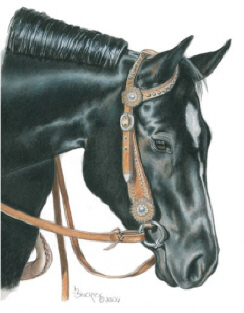|
"Annie"
|
 |
|
Step One
This drawing is a portrait of a little Quarter Horse Mare that belonged to my daughter . I've started the drawing by transferring the preliminary sketch to Fabriano Watercolor paper. One of my favorite parts of a portrait is the eyes. It's what brings the drawing to life, so usually I'll start with the eyes. The pencils used to create the eye are: Prismacolor Verithin Black to define the shape of the eye and eyelids, Prismacolor Black around the peripheral of the eyeball, Prisma Sienna Brown for the iris,White for the glisten in the eye and eye lids. The lashes are Prisma Cool Grey 20%. Burnish the iris with White then soften it into the rest of the eye with a Colorless Blender. I've also defined the outline of the head, ears, nostrils, bridle, etc with Verithin Black. The shadows and dark areas on the face are softly layered by using a circucular motion with Prismacolor Black. Prisma Sienna Brown is also used where the black hair is faded around the eyes, ears and nostril. |
 |



 The
insert shows the detail of the bridle and snaffle bit. The colors used on
the bit and conchos are: Prismacolor Cool Grey 50%, Copenhagen Blue,
Verithin Black, burnished with White. The horse's coat as well as the
metal reflect the blue of the sky.
The
insert shows the detail of the bridle and snaffle bit. The colors used on
the bit and conchos are: Prismacolor Cool Grey 50%, Copenhagen Blue,
Verithin Black, burnished with White. The horse's coat as well as the
metal reflect the blue of the sky.